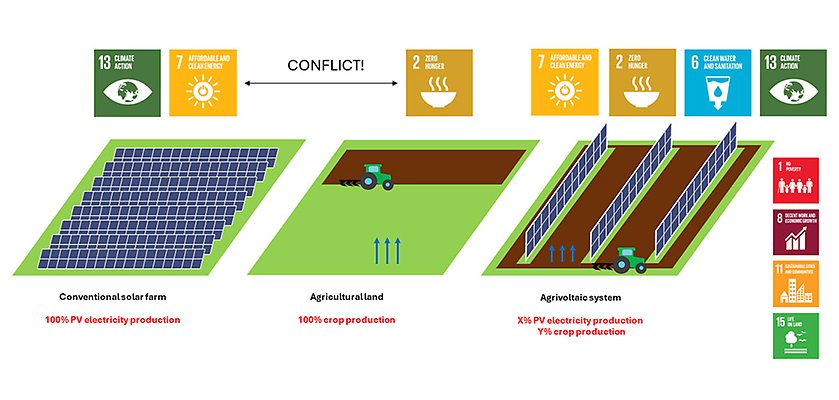Avoiding conflicts between the sustainable development goals through agro-photovoltaic systems

A common criticism to large-scale solar farm is the competition between land for energy and land for food that creates deep conflicts among the Sustainable Development Goals (SDGs). One of the sustainable and technological solutions to address the SDGs competition is the adoption of agro-photovoltaic systems, which combine electricity and crop production and increase land use productivity.
By using a water-food-energy-climate nexus approach, this project aims to provide an in depth understanding on the interrelationships between solar radiation distribution at crop level, photovoltaic production, microclimate, and crop yield response underneath of the APV systems. In particular, the project will investigate through experiments how complex shading conditions created by agro-photovoltaic systems affect the distribution of the albedo and of the photosynthetically active radiation converted into biomass by crops.
Project website
Start
2022-01-01
Planned completion
2025-12-31
Main financing
Research area
Research group
Project manager at MDU
Background
A common criticism to large-scale solar farm is the competition between land for energy and land for food that creates deep conflicts among the Sustainable Development Goals (SDGs). One of the sustainable and technological solutions to address the SDGs competition is the adoption of agro-photovoltaic systems, which combine electricity and crop production and increase land use productivity.
By using a water-food-energy-climate nexus approach, this project aims to provide an in depth understanding on the interrelationships between solar radiation distribution at crop level, photovoltaic production, microclimate, and crop yield response underneath of the APV systems. In particular, the project will investigate through experiments how complex shading conditions created by agro-photovoltaic systems affect the distribution of the albedo and of the photosynthetically active radiation converted into biomass by crops. State-of-the-art algorithm for solar radiation decomposition will be developed. The project will also investigate through an energy balance approach how the microclimate underneath of agrivoltaic systems affects the electricity production of solar cells and the crop yield by developing an integrated water-food-energy nexus model for agro-photovoltaic system.
The developed model will be sued to analyses on a large scale the effects of implementing agro-photovoltaic systems as a mitigation and adaptation technology to extreme weather phenomena and climate changes.
Cooperation
The project is carried out at Kärrbo Prästgård outside Västerås and throughout Sweden in collaboration with several national and international partners who work in remote sensing, solar radiation, modeling of crops and solar cells. This project addresses the world's commitments to the UN's goals for sustainable development, in particular No Hunger, Sustainable Energy and Combating Climate Change. It is also in line with the Swedish government's goal of having 100 percent renewable electricity production by 2040 and achieving no net greenhouse gas emissions by 2045. The project is also in line with the Swedish goals of having a strong and competitive agricultural sector that can mitigate climate change and adapt to a changing climate.
Project goals
The purpose of the project is to study how agrovoltaic systems can overcome the conflict between sustainable development goals and co-produce electricity and food on the same land.
The overall purpose will thus be to provide an in-depth understanding of the connections between solar radiation distribution at crop level, solar cell production, microclimate and the harvest response under agrovoltaic systems.
The main goals of the project include:
- development of groundbreaking algorithms to understand how the shadows produced by the PV modules affect the harvest
- perform experiments at the experimental facility located at Kärrbo Prästgård for model validation
- scale up the model at the national level to better understand how agrovoltaic systems can function as a climate adaptation technique.
Publications
https://www.sciencedirect.com/science/article/pii/S0306261923003458 External link.
External link.
https://www.sciencedirect.com/science/article/pii/S0959652623043937 External link.
External link.
https://www.sciencedirect.com/science/article/pii/S0378377422002815?via%3Dihub External link.
External link.
https://www.sciencedirect.com/science/article/pii/S0038092X22003917?via%3Dihub External link.
External link.
Follow this project on LinkedIn
Project page on LinkedIn